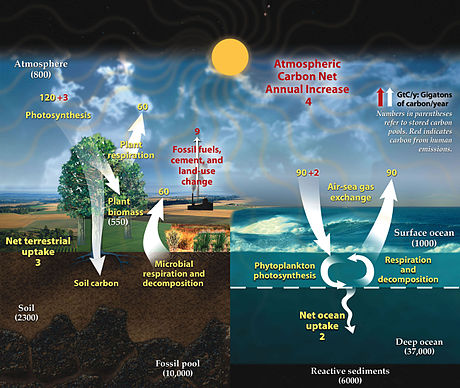INTRODUCTION – Carbon Cycle
Just as the “water cycle” describes the transfer of water molecules between rivers, oceans, land and the atmosphere, the “carbon cycle” refers to the flow of carbon through different parts of the Earth system – including the air and the bodies of plants and animals.
The carbon cycle is a natural and integral part of life on Earth. A single carbon atom stored in a blade of grass may shift to the body of an animal that eats the grass. When the animal dies, its body might rot, and the carbon atom could join with oxygen to form CO2 in the air. From there it might be taken in by a tree in the process of photosynthesis and used as a building block in a branch or trunk, or absorbed by the ocean. And so on.
Although the basic flows of the carbon cycle haven’t significantly changed, in the last century or so humans have increased the amount of CO2 in the air by taking carbon that has been locked up in the ground for millions of years – in the form of oil, coal and gas – and releasing it into the atmosphere by burning those fuels. There is strong evidence that this has led to global warming.
EXPLANATION
The carbon cycle is the biogeochemical cycle by which carbon is exchanged among the biosphere, pedosphere, geosphere, hydrosphere, and atmosphere of the Earth.
Like the Earth energy balance, the global carbon budget is the balance of the exchanges (incomes and losses) of carbon between the carbon reservoirs or between one specific loop (e.g. atmosphere ↔ biosphere) of the carbon cycle. An examination of the carbon budget of a pool or reservoir can provide information about whether the pool or reservoir is functioning as a source or sink for carbon dioxide.
 http://en.wikipedia.org/wiki/Carbon_cycle
http://en.wikipedia.org/wiki/Carbon_cycle
How does it work?
Carbon in the earth’s atmosphere exists in two main forms: carbon dioxide and methane. Both of these gases absorb and retain heat in the atmosphere and are partially responsible for the greenhouse effect. As an animal breathes (respires), it exhales carbon dioxide, returning it back to the atmosphere. When an animal or plant dies, it is broken down by bacteria and fungi and again the carbon is released (this process is called decomposition). Sometimes, instead of completely decomposing, a plant or animal may be fossilised, leading to its carbon being stored in a rock. After millions of years and under the right conditions, these fossils may turn into fossil fuels (oil, coal and natural gas).
Moreover, the terrestrial biosphere includes the organic carbon in all land-living organisms, both alive and dead, as well as carbon stored in soils. About 500 gigatons of carbon are stored above ground in plants and other living organisms, while soil holds approximately 1,500 gigatons of carbon. Most carbon in the terrestrial biosphere is organic carbon, while about a third of soil carbon is stored in inorganic forms, such as calcium carbonate.
To add to that, oceans contain the greatest quantity of actively cycled carbon in this world and are second only to the lithosphere in the amount of carbon they store. The oceans’ surface layer holds large amounts of dissolved organic carbon that is exchanged rapidly with the atmosphere.
Why is the Carbon Cycle important?
- From the time when the first living organisms coalesced in a sea permeated with long-chained molecules, carbon has been essential to life on earth. Carbon’s importance arises from its crucial provision of both structure and energy to living creatures. Carbon’s very long chains and rings are the backbones of most organic molecules. Break living bodies of any sort into organs, break the organs into cells, and the cells into molecules, look inside, and you will find a string of carbon atoms. If you could somehow pull all these carbon strings from the organism, little would remain of either the organism’s form or function. Carbon also flows through organisms and, when doing so, provides the energy that allows them to perform the various functions that we associate with being alive. This energy comes stored in the molecular bonds that hold the carbon chains together.
- The carbon cycle is important in ecosystems because it moves carbon, a life-sustaining element, from the atmosphere and oceans into organisms and back again to the atmosphere and oceans. If the balance between these latter two reservoirs is upset, serious consequences, such as global warming and climate disruption, may result.
- While CO2 is only a very small part of the atmosphere (0.04%), it plays a large role in the energy balance of the planet. CO2 in the atmosphere acts like a blanket over the planet by trapping longwave radiation, which would otherwise radiate heat away from the planet. As the amount of CO2 increases, so does its warming effect. CO2 is the largest contributor (currently 63%) to this effect by long-lived gases and its role increases each year.
REFERENCES
- Carbon Cycle (Wikipedia)
http://en.wikipedia.org/wiki/Carbon_cycle - Carbon Cycle Science (ESRL News)
http://www.esrl.noaa.gov/research/themes/carbon/ - The Carbon Cycle : Feature Articles (NASA)
http://earthobservatory.nasa.gov/Features/CarbonCycle/ - What is the Carbon Cycle? (The Guardian)
http://www.theguardian.com/environment/2011/feb/25/carbon-cycle - Archer, David: The Global Carbon Cycle.
Princeton University Press, 2010.
